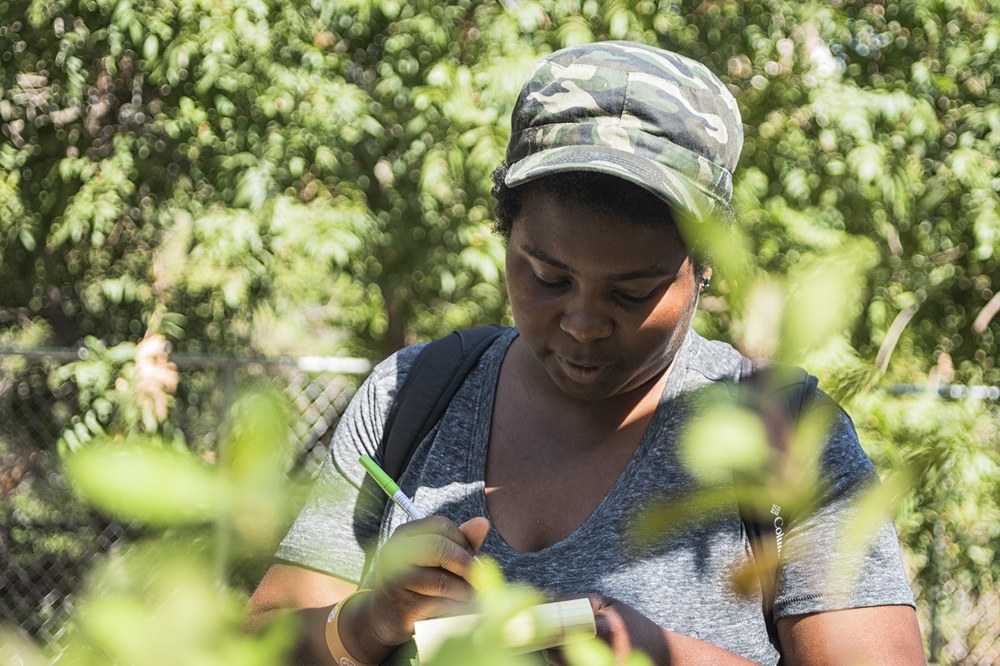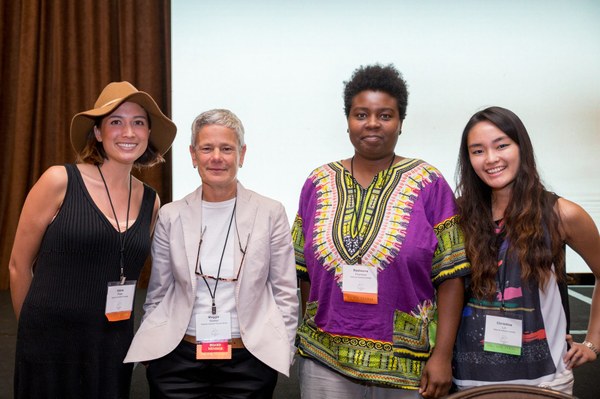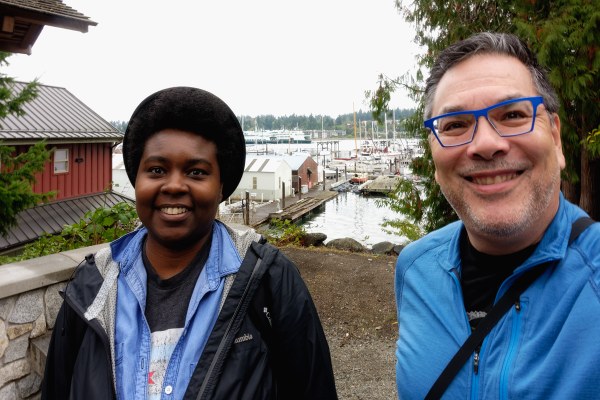
I am by nature a city girl. I enjoy bright lights and long walks down populated concrete sidewalks while street musicians fill the air with tunes. I am from Chicago, land of blues and backyard barbecue smells, where as a child I played double dutch near curbs on city streets in my Westside neighborhood. Big-city noises such as loud car motors and high-volume voices drowned out the sounds of pigeons, crows, and ravens, but the city was their home too.
For a lot of my life, I ignored the natural settings that made up my urban landscapes and rarely took note of the birds flying around me. A recent fellowship with the National Audubon Society changed that for me.
This summer demonstrated that there is a place for me in the environmental field when I began as a Walker Communications Fellow with the National Audubon Society. The fellowship was developed by Maggie Walker, who is the second woman ever to serve as chair of the National Audubon Society’s board. She’s very active in the Seattle community, supporting the arts, cultural communities, and inclusion. Among many other things, she is a past president of the Seattle Art Museum and presently chairing Friends of Waterfront Seattle. I was able to meet with Maggie, and I was inspired and motivated by her achievement as a philanthropist and her community involvement; it’s an experience that has further shown me the power of giving back to the community.
 The Walker Fellows with program namesake Maggie Walker (l-r): Alana Phan, Rasheena Fountain and Christine Lin. Photo by Camilla Cerea / Audubon.
The Walker Fellows with program namesake Maggie Walker (l-r): Alana Phan, Rasheena Fountain and Christine Lin. Photo by Camilla Cerea / Audubon.
The fellowship allowed me to travel for environmental journalism with Glenn Nelson, a mentor journalist. Glenn is a writer of color, and it has been powerful to get his perspective as a veteran journalist and writer, as well as someone who understands the complexities of natural environments and race. He was a Seattle Times reporter and columnist for 17 years, worked for ESPN, was a contributing editor for High Country News, and is the founder of The Trail Posse, which specifically deals with race and inclusion in the outdoors.
I also got to hone my communications skills at Seward Park Audubon Center and at Audubon Washington in Seattle. And to be honest, I never thought I would work for Audubon, especially since I’m a black non-birder.
In college I was exposed to environmental writer Rachel Carson, author of Silent Spring. Her words, and the words of others, raised my awareness of environmental justice issues, such as air pollution, water pollution and climate change, which disproportionately affect poor people of color. A lot of my family lives in inner city Chicago, so I became motivated to enhance environmental education in communities of color. I want to empower communities to speak up against environmental hazards and to notice and protect the nature around them.
I’m getting my master’s degree in urban environmental education at Antioch University and I have an undergraduate degree in creative writing from the University of Illinois at Urbana-Champaign. The program at Antioch is in partnership with IslandWood, a nature education center in Bainbridge Island, Washington. I have continued to focus on social justice issues like climate change. I have also studied cultural heritage in the environment, urban ecology, and civic engagement to influence environmental policy. While I’ve studied applied ecology at the graduate level, I never explicitly studied ornithology, the study of birds. However, my passion for conservation, ecology, and environmental justice reflected my landing at Audubon.
At Seward Park Audubon Center, where I was stationed in Seattle, I was comforted by the familiarity of the messages floating in the wind miles away from Chicago. The center is located in a park with acres of old-growth forest, surrounded by an urban setting where people from many cultural backgrounds walk its trails amid the biodiversity of bird species gracing its grounds. Ravens and crows live here, but so do great blue herons, pileated woodpeckers, barred owls, kingfishers, and other, less urban birds.
I silently searched for owls with other city dwellers in the darkness on Seward Park trails during Nighttime Bird Walks, one of the center’s popular events. I saw a dark-eyed junco’s nest filled with wiggling hatchlings nestled near the ground within a tree stump. I heard the nighttime sounds of an eagle responding to recordings of owlet bird calls that Marina Pita, community programs manager at the Seward Park Audubon Center, played on her smartphone. I watched as people who had lived in the neighborhood for years gazed in awe at the natural landscapes, making new connections with their environment. In the company of others, I relaxed in the dark forest, a place I would have been more hesitant to enter back home. I gained a new appreciation of the lively nighttime ecosystem. Eventually, the path led to pristine lakeside views of the brightly lit Seattle skyline as bats flew above us.
During a Saturday morning program called “Morning Treats and Tweets,” I watched Joey Manson radiate with excitement as he spouted bird facts and encouraged millennials, families, and children to explore the old-growth forest. Joey is the Seward Audubon Center director and the only African-American director in the Audubon’s national network of 41 centers. “Morning Treats and Tweets” combines novice bird watching with free pastries, caffeinated drinks and binoculars for close-up bird views. Joey exposes community and youth to assorted facets of nature like his favorite birds, the Anna’s hummingbird and pileated woodpeckers that decorate the Seward Park landscape.
Ed Dominguez, the lead naturalist at Seward Park Audubon, led the “Treats and Tweets” bird walk. Ed is an Edmonds School District music teacher and nature series host on KBCS 91.3 FM — a Seattle public radio station. Children, mothers, fathers, grandparents, and young professionals gazed at great blue herons, kingfishers, barred owls, and mallard duck families through their binoculars with Ed. People were excited to see owls up-close for the first time. This excitement was heightened by Ed’s natural enthusiasm and communicative, harmonious interactions with his surroundings. I became lost in the encounters, feeling curious like the toddlers and children who wander curiously on the park’s trails.
 RASHEENA FOUNTAIN AND GLENN NELSON. PHOTO COURTESY OF GLENN NELSON.
RASHEENA FOUNTAIN AND GLENN NELSON. PHOTO COURTESY OF GLENN NELSON.
Watching Marina Pita spark curiosity through storytelling about ladybugs, owls, and other animals during the Toddler Tales and Trails program has been inspirational. Pita is Latina and has experience teaching in dual-language elementary education programs in the South Park neighborhood of Seattle. This is an influence that has contributed to her ability to communicate nature to toddlers in diverse ways. She previously worked at Seward Park in a different position, but was inspired to get her master’s degree in elementary education after being exposed to environmental education at the center. She returned six years later, and is now teaching the Toddler Tales and Trails storytelling program that encourages toddlers in the community to discover story concepts in natural settings. Encouraging toddlers to notice nature in their neighborhoods will prompt them to be more connected to their environment. I envision them being able to view the birds and forests around them as live companions that dwell communally in their spaces.
Audubon is known for birds — and bird lovers, who now are mostly older and white. I admit, I applied for the fellowship because of my interest in writing about the environment, not so much because I wanted to work at Audubon. It wasn’t until I started working there that I learned about the intersection of so many of my interests. In 2014, the organization published the Audubon Birds and Climate Change report, which predicts how birds in the U.S. and Canada may respond to a changing climate. I also have learned about Audubon Washington’s support of carbon pricing to reduce pollution that causes climate change. As a black woman in the environmental field, I have been impressed with the commitment to diversity within Audubon by David Yarnold, the organization’s president and CEO.
During a recent interview that Yarnold conducted with me and other fellows and interns, he said, “I believe that Audubon’s effectiveness relies on the ability to be culturally knowledgeable. What we say doesn’t matter. It’s about what we do.”
I stand by Yarnold’s statement. Audubon has managed to get this city-loving girl immersed in the world of birds at its Seward Park Audubon Center. My windows face Lake Washington, where kids swing on the playground beneath skies where the great blue herons, ravens, and eagles soar. And I notice the birds now. I notice the living habitats supporting diverse life — life threatened by climate change and other habitat destruction. With this new perspective and appreciation for birds, I am inspired to share Audubon’s message in hopes of inspiring others to protect and learn about these habitats as well.
This article originally appeared in our Winter 2018 issue of Mountaineer Magazine. To view the original article in magazine form and read more stories from our publication, click here.
 Rasheena Fountain
Rasheena Fountain